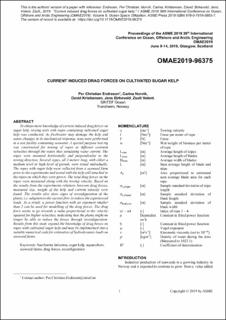| dc.contributor.author | Endresen, Per Christian | |
| dc.contributor.author | Norvik, Carina | |
| dc.contributor.author | Kristiansen, David | |
| dc.contributor.author | Birkevold, Jens | |
| dc.contributor.author | Volent, Zsolt | |
| dc.date.accessioned | 2021-01-08T09:19:29Z | |
| dc.date.available | 2021-01-08T09:19:29Z | |
| dc.date.created | 2019-11-12T14:33:14Z | |
| dc.date.issued | 2019-06 | |
| dc.identifier.citation | ASME 2019 38th International Conference on Ocean, Offshore and Arctic Engineering (OMAE2019): Volume 6: Ocean Space Utilization | en_US |
| dc.identifier.isbn | 978-0-7918-5883-7 | |
| dc.identifier.uri | https://hdl.handle.net/11250/2722144 | |
| dc.description.abstract | To obtain more knowledge of current induced drag forces on sugar kelp, towing tests with ropes containing cultivated sugar kelp was conducted. As freshwater may damage the kelp and cause changes in its mechanical response, tests were performed in a test facility containing seawater. A special purpose test rig was constructed for towing of ropes at different constant velocities through the water, thus simulating water current. The ropes were mounted horizontally and perpendicular to the towing direction. Several ropes, all 3 meters long, with either a medium level or high level of growth, were tested individually. The ropes with sugar kelp were collected from a seaweed farm prior to the experiments and tested with the kelp still attached to the ropes on which they were grown. The total drag forces on the ropes were measured along with the towing velocity. Based on the results from the experiments relations between drag forces, measured size, weight of the kelp and current velocity were found. The results also show signs of reconfiguration of the plants, i.e. adaption to the current flow to reduce the experienced loads. As a result, a power function with an exponent smaller than 2 can be used for modelling of the drag forces. The drag force seems to go towards a value proportional to the velocity squared for higher velocities, indicating that the plants might no longer be able to reduce the forces through reconfiguration. Results from this study expand the knowledge of drag forces on ropes with cultivated sugar kelp and may be implemented into a suitable numerical code for estimation of hydrodynamic loads on seaweed farms. | en_US |
| dc.language.iso | eng | en_US |
| dc.publisher | ASME | en_US |
| dc.relation.ispartof | ASME 2019 38th International Conference on Ocean, Offshore and Arctic Engineering (OMAE2019): Volume 6: Ocean Space Utilization | |
| dc.rights | Attribution-NonCommercial-NoDerivatives 4.0 Internasjonal | * |
| dc.rights.uri | http://creativecommons.org/licenses/by-nc-nd/4.0/deed.no | * |
| dc.subject | Saccharina latissima | en_US |
| dc.subject | sugar kelp | en_US |
| dc.subject | Aquaculture | en_US |
| dc.subject | seaweed farms | en_US |
| dc.subject | drag forces | en_US |
| dc.subject | reconfiguration | en_US |
| dc.title | Current induced drag forces on cultivated sugar kelp | en_US |
| dc.type | Chapter | en_US |
| dc.description.version | acceptedVersion | en_US |
| dc.rights.holder | Accepted manuscript © the authors 2019 | en_US |
| dc.source.volume | Volume 6: Ocean Space Utilization | en_US |
| dc.identifier.doi | 10.1115/OMAE2019-96375 | |
| dc.identifier.cristin | 1746624 | |
| dc.source.articlenumber | OMAE2019-96375, V006T05A007 | en_US |
| cristin.ispublished | true | |
| cristin.fulltext | postprint | |
| cristin.qualitycode | 1 | |

